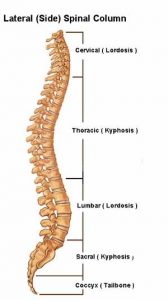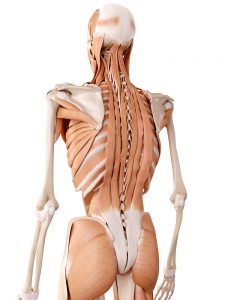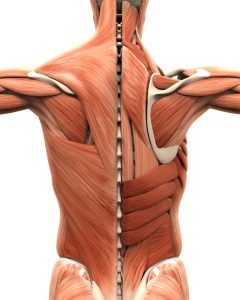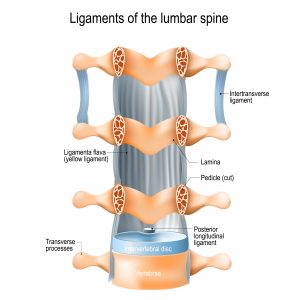Muscle and Ligament Pain in the Spine
Soft tissue structures (muscles and ligaments) in the spine are fundamental in controlling our general movement and coordination.
Lower back pain – the main muscles
If we included all the muscles involved directly or allied with spinal movement I would be writing an entire anatomy book!
Soft tissue structures (muscles and ligaments) in the spine are fundamental in controlling our general movement and coordination. Obviously to enable this role they are the main structures surrounding the spine and it therefore follows that they will also be involved in most traumatic or repetitive injuries to the spine.
It is worth mentioning that there are a lot of tiny muscles that help connect the vertebrae together such as intertransverse and interspinales muscles. These are not responsible for executing movement but do have a big role in proprioception (sense of joint position).
Briefly there are three groups of muscles in the lower back. These, quite simply, allow us to bend forwards, backwards and side to side.
Flexor muscles in the spine
The main spinal muscles allowing forward movement are the flexor muscles in the lower back. These attach to the front of the spine and enable bending forward, lifting, and arching the lower back. The key muscle in this category is the psoas muscle. Essentially the psoas helps pull the vertebra at the bottom of your back forward and down.
Your psoas muscle is very important because it helps to create the curve in your lower back. This curve helps absorb and transfer weight from the lower to your upper limb as you walk by absorbing stress. This curve is called a lumbar lordosis as seen in the diagram below.
Many injuries are sustained by lifting and these injuries can involve the psoas as it has a key role. Lifting also activates the muscles in the front of your hip joints as well which act eccentrically (this means they lengthen and stretch under load as you bend forwards). This includes the biggest muscle called gluteus maximus and the piriformis muscle that connects the top of your thigh bone (the femur) to your pelvis and gluteus minimus and gluteus medius.
Extensor and side-bending muscles in the spine
One of the main muscle groups allowing us to bend backwards are the extensor muscles. These are attached to back of the spine and enable have key roles in maintaining our posture.
As we lean forwards they elongate and stretch under load eccentrically and contract and shorten as straighten up (or concentric contraction). These muscles include the large paired muscles in the lower back, called the erector spinae and the multifidis muscle groups. The erector spine muscles run the entire length of the spine and attach to your ribs, vertebra and pelvis and help keep you upright.
The Quadratus Lumborum (QL) muscle, as seen in the diagram above, has a vital role in side bending your spine. The QL is a deep muscle that runs on both sides of the lower back. The muscle begins on the lowest rib (rib 12) and the nearby vertebra and connects to the pelvic crests.
The QL is responsible for stabilising the lower back while upright and has a role in side bending. This muscle is often injured or strained if lifting includes rotation (i.e. bending and twisting).
Mid-back pain – the main muscles
The most common cause of mid-back pain comes from muscular related issues or other soft tissue structures. These problems can arise from different scenarios ranging from poor posture, such as prolonged sitting at a work station, heavy lifting or traumatic incidents in contact sports.
The correct term for the middle of the spine is the thoracic spine and this comprises twelve vertebrae and twelve sets of ribs. Allied to these structures is the shoulder blade that acts in unison with shoulder movement. This is because the main shoulder socket (called the glenoid) has a bony connection with the shoulder blade and is actually part of the same structure.
Not many of us realise that the shoulder blade does not attach to the skeleton (apart from one tiny joint that joins the collar bone). The shoulder blade is therefore, out of necessity, surrounded by and encapsulated in heavy musculature. This enables it to serve as an anchor when the muscles contract, so we can move our arms freely when required (many of these muscles are seen in the diagram below). The most important muscles in this group include the Rhomboids (on the inside of the shoulder blade), the Trapezius muscle (seen in red below) and Latissmus dorsi.
The shoulder blade is integral to any shoulder movement involving throwing or lifting. Many of the muscles associated with these movements can generate what can feel like spinal pain.
Another important point is that muscles responsible for rotation/movement in the neck can also be a source of pain to the upper back.
Lastly, it is also worth remembering that soft tissue symptoms in this area can also be allied with rib or spinal joint pain (refer spinal joint pain).
Lower back pain – the main ligaments
A ligament is a tough band of tissue that restricts excessive movement and connects two bones. The spinal ligaments obviously connect the vertebrae of the spine together and provide stability for posture and spinal movement of our spines. They also help connect the spine to the pelvis.
There is no doubt that ligament damage contributes to lower back pain. However, it is very hard to diagnose ligament pain specifically because there are no conclusive valid tests to achieve a diagnosis.
The strongest ligament in the lower back is the iliolumbar ligament, which anchors the bottom vertebra in position. Some preliminary studies demonstrate a 10-14% involvement in typical presentations relating to lower back pain. However, much of the current data remains inconclusive.
In the pelvis itself, the sacrum and the iliac bones (ileum) are held together by an extensive collection of strong ligaments. These can be damaged and are a potential source of lower back pain. Some studies suggest that the prevalence of SI joint pain accounts for up to 20% of chronic back pain presentations.
One of the most significant ligaments in the spine is the ligamentum flavum (flavum means yellow and this is really is the colour of this specific ligament). The ligamentum flavum is a short but thick ligament that connects vertebrae together. Its elasticity serves to preserve our upright posture.
This ligament however can become inflamed due to stress on the spine and this often occurs in people over the age of 50 due to the natural degeneration process of the spine. As the structures in the spine degenerate stress increases on the ligamentum flavum.
When this happens cells in the ligament become inflamed (hypertrophy) and begin to ossify or thicken. This increase in size and decrease in elasticity occasionally combine to reduce the area available for nerve roots and the spinal cord to pass (spinal stenosis).





